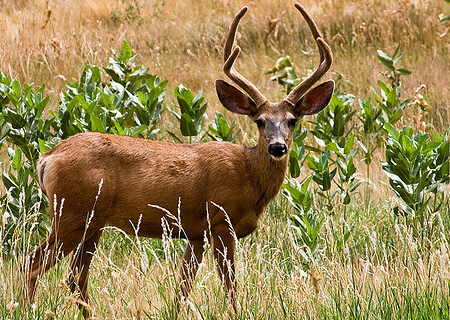
Wildlife is the population of undomesticated animals, usually living in a natural environment, including both game and nongame species. In Utah “wildlife” includes vertebrate animals (fish, amphibians, reptiles, birds, mammals) as well as brine shrimp, crayfish, and mollusks.[1]
Related resource topics for county planning include:
The Utah Division of Wildlife Resources (UDWR) has provided the following resources to help counties create resource management plans for wildlife and other resources.
- Draft county resource planning goals prepared by UDWR can be downloaded from this link at countyrmp.org.
- The Utah Wildlife Action Plan addresses species in need of conservation attention. The plan, first created in 2005, currently has a draft 2015 update available for public viewing.
- A listing of wildlife species by county, including animals on the Endangered Species Act.
The habitat data can be used to identify the parts of the county that are important to a particular wildlife species.
Wild Aware Utah is a program to educate Utah residents about wildlife and safety, including what to do in a wildlife emergency.
Best management practices (BMPs) for wildlife focus on principles and actions that allow humans and wildlife to coexist and on creating or maintaining healthy wildlife populations and habitat.
The Wildlife Action Plan considers key habitats and provides management strategies to improve the habitat’s condition (see pages 73–123 of the plan). Also, the plan considers threats and provides actions to reduce the threats (see pages 124–216 of the plan).[2]
The Wild Utah Project created BMPs for Off Road Vehicles use and Renewable Energy Development that protects wildlife.
The Conservation Habitat Management Portal provides BMPs for wildlife habitat management, specifically for sage grouse.
The Grand Canyon Trust created BMPs for living and working with beavers.
A national survey conducted of the year 2011 by the US Fish & Wildlife Service found that Utah residents and non-residents spent over $1.5 billion dollars that year in Utah for wildlife associated recreation activities.[3]
Number of participants and total expenditures in Utah in the year 2011.| Activity | Number of Participants | Total Expenditures | Average per Participant |
|---|---|---|---|
| Fishing | 414,000 | $451,259,000 | $1,089 |
| Hunting | 193,000 | $499,141,000 | $2,334 |
| Wildlife Watching | 717,000 | $585,406,000 | $801 |
| Totals | 1,324,000 | $1,535,806,000 | $1,159 |
The hunting unit data can be used to identify the parts of the county that hunting is allowed for a particular species.
The following considerations are summarized from information prepared by UDWR[1] for county resource management planning, available at countyrmp.org:
- Energy development and transmission may cause impacts to valued wildlife species; development-related impacts need to be mitigated to promote a balance among competing uses.
- It is reasonable to assume that air pollution affects other higher order animals in the same ways that it affects humans, although effects on wildlife are not well documented. The effects of dust and other particulate forms of air pollution on animal ecology are becoming a more widely recognized subject of interest.
- Water management needs to be carefully considered, so that we can meet municipal and industrial needs, while preserving traditional agricultural uses, and ensuring aquatic habitat to support wildlife.
- Thriving populations of big game animals will, at times, cause some level of damage to farming and ranching operations, by competing with domestic livestock for available forage, or by damaging crops, fences, or irrigation equipment. A number of methods can be applied to mitigate the damage, including various forms of wildlife harvest and removal, issuance of landowner permits, development of a conservation lease which involves remuneration or other forms of compensation for depredation, and, finally, direct monetary compensation for agricultural damages.
- Utah’s Watershed Restoration Initiative (WRI) provides a balancing influence that promotes wildlife values and supports agricultural needs. To participate effectively, counties need their staff to attend meetings of the WRI regional teams, expressing their views and advocating for the kinds of watershed restoration efforts they feel are most important.
- Management plans provide guidance and direction for a number of species in Utah. These plans are taken through a public process to gather input from interested constituents and then presented to the Wildlife Board for approval. Species covered by statewide plans include wild turkey, chukar, greater sage-grouse, mule deer, elk, moose, pronghorn, mountain goat, bighorn sheep, Utah prairie dog, beaver, northern river otter, black bear, cougar, bobcat, and wolf.
| Data Name | Data Explanation | Publication Date | Spatial Accuracy | Contact |
|---|---|---|---|---|
| Wild Horse and Burro Herd Areas | To identify wild horse and burro herd areas. | 6/15/2009 | 1:24,000 to 1:250,000 | Bureau of Land Management in Utah |
| Utah 2016 Hunt Units , | Locate hunting units by species; bear, deer, elk, OILT, pronghorn, moose, mt. goat | 2016 | 1:5,000 | Utah Division of Wildlife Resources |
| Wild Horse and Burro Herd Management Areas , | To identify wild horse and burro Herd Management Areas | 2001 | 1:250,000 | Bureau of Land Management in Utah |
| Cooperative Wildlife Management Units , | Location of private and state cooperative efforts to manage wildlifes | 2015 | 1:5,000 | Utah Division of Wildlife Resources |
| Div. of Wildlife Resources Regions , | Use to locate State wildlife management region | Unknown | Unknown | Utah Division of Wildlife Resources |
| Species Habitat | Use to locate habitat areas by species. Species list Here | Variable | 1:100,000 | Utah Division of Wildlife Resources |
References
- Utah Division of Wildlife Resources. 2016. County Resource Management Plans – General information on Wildlife. Presented at 10 Nov 2015 Coordinating Meeting.
- Utah Department of Natural Resources, Utah Division of Wildlife Resources. 2015. Utah Wildlife Action Plan, Draft Version 6-4-2015.
- U.S. Fish and Wildlife Service. 2014. National Survey of Fishing, Hunting, and Wildlife-Associated Recreation, FHW/11-UT (RV).